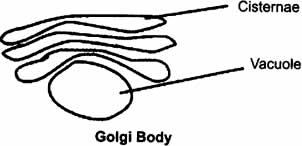Question: What is the Junction of plastids?
Answer: Plastids are present only in plant cells. There are two types of plastids chromoplasts (colored plastids) and leucoplasts (white or colorless)
Chromoplast:Consists of colored pigments and gives different colors to flowers, fruits and leaves. The green color pigment present in leaf is called chlorophyll which helps in the photosynthesis and a plastid with chlorophyll is called chloroplast.
Leucoplast: It stores starch, oil and protein granules in it.
Question: Do vacuoles store some material? If yes, name them.
Answer: Yes, vacuoles also store some important substances required in life of the plant cell. These are amino acids, sugars, various organic acids and some proteins. In some unicellular organisms, e.g. Amoeba, vacuoles also store food.
Question: Explain the structure and function of Golgi bodies.
Answer:
Structures: Golgi bodies consist of a system of membrane-bound vesicles arranged in stacks parallel to each other called cisterns. These membranes have connections with the membrane of endoplasmic reticulum (ER).
Functions:
- The material synthesized near the ER is packaged and dispatched to various target inside and outside the cell through Golgi apparatus.
- It also stores, modifies and helps in the packaging of products in vesicles.
- In some cases, complex sugars may be made from simple sugars in it.
- It also helps in the formation of lysosomes.
Question: What are ribosomes? Where are they located in the cell? What is their function?
Answer: Ribosomes are spherical organelles present in the cell which are either freely distributed in the cytoplasm or may be attached to the endoplasmic reticulum.
It consists of ribosomal RNA (Ribonucleic acid) and proteins.
Functions of Ribosomes: It helps in the synthesis of proteins.
Question: What is the difference in chromatin, chromosomes and gene?
Answer:
- Chromatin: It is a fine network of thread-like structure made up of DNA or RNA. It gets condense to form chromosomes.
- Chromosome: The chromosomes are made from chromatin material and are located iri the cell.
- Genes are found in chromosomes.
Question: Why do plant cells have more in number and big-sized vacuoles as compared to the animal cells?
Answer: Plant cells attain turgidity and rigidity due to the more number of vacuoles as well as large-sized vacuoles help the plant cells to withstand the wear and tear, external environmental conditions.
They also help in the storage of essential material required by plants for their growth like amino acids, sugar and various organic substances.
Question: Explain the following terms:
- Plasma membrane
- Cytoplasm
- Nucleus
Answer:
- Plasma membrane: It is a thin membrane which controls the passage of materials in and out of the cell. It is also called as selectively permeable membrane. It makes the outer boundary of the cell and is made up of lipo-protein,
- Cytoplasm: It is transparent jelly-like thick substance present in the cell. It makes the ground of the cell in which all the cell organelles are suspended.
- Nucleus: It is a double-layered membrane structure which contains chromosomes required for the inheritance of characteristics from one generation to the other.
 Class Notes NCERT Solutions for CBSE Students
Class Notes NCERT Solutions for CBSE Students




